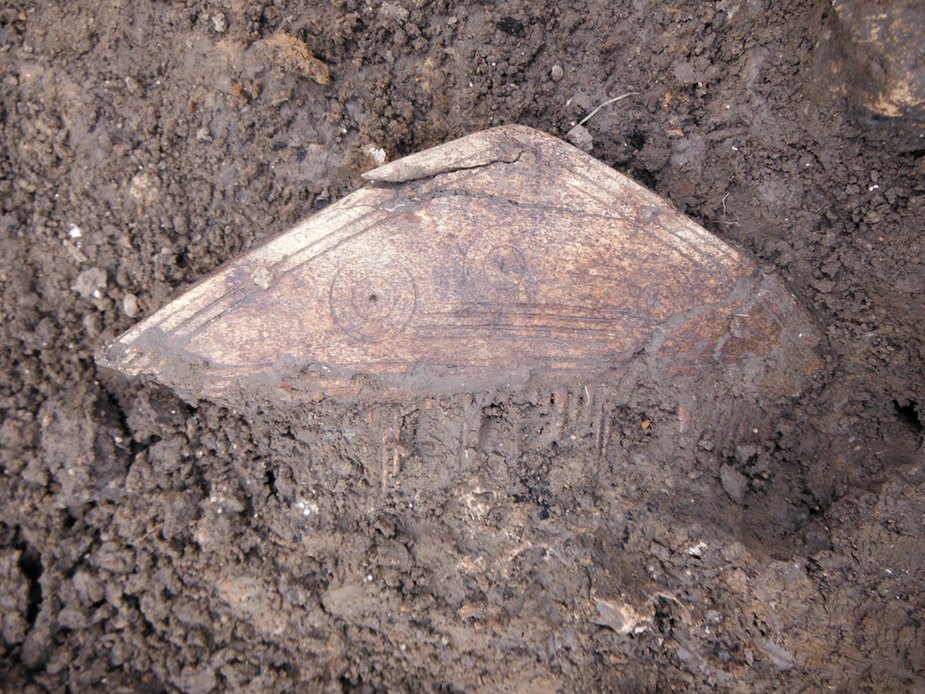Things are going rather well here with gorgeous sunny days that are hot and tiring to work in but certainly cheer everyone up after the dull and oppressive days we’ve had recently. It is nice not to have to prise three inches of mud off of your boots before you can get in your car and go back to the campsite!

Local volunteer Danielle cuts up the delicious cake made for us by her aunt Shena Winning, also one of our volunteer diggers
It must be said that the change in weather does not seem to affect volunteer numbers – people are turning up come rain or shine which is really wonderful. We’re thrilled to have so much community support. So far over 80 people have signed up and volunteered some of their time on the project, whether digging, finds washing, environmental processing or even making tea and generously providing cake for hungry diggers!
I promised I would give the full lowdown on the discovery of the bone comb – but I am now able to bring you several more exciting finds to go with it! I’ll start with the comb, which came up on the 9th August in the sunken-featured building (SFB).
Ben was carefully excavating around an upside-down animal skull, when he spotted some bone just underneath it that looked a little different, with a circle engraved onto it. I had a closer look and saw that it looked like
the ring and dot decoration common on worked Saxon bone, and in particular on bone combs from the Saxon period. We had to carefully clean around the skull and the comb to expose it, and see what the best way to lift it might be. The more we cleaned back the larger it got, and you can see from the pictures that it is a very complete example, with a few fractures probably from being jumbled in with the animal skulls that are scattered through the SFB. We are now keeping it damp to stop it from cracking and drying out,
which would be detrimental to its preservation, before we can get it to a specialist conservator. There are very few examples of these triangular combs from Kent – most of the known examples come from Suffolk.
The comb is not our only exciting recent find. David Holman, who has been metal-detecting for us for some years now, went over the site yesterday to let us know where any non-iron signals were coming
up. He got two very exciting signals – one from the medieval ditch that runs across the whole site, and another from the eastern wall of the hall building. Gabor decided that as we were not going to be fully excavating the medieval ditch which already has four slots opened over it, that as the signal was only an inch or so below the surface, we could carefully extract the metal object David had identified in the ditch. Usually we would leave such items in for excavation by hand, but in some cases it makes more sense to extract them
earlier. In this instance we were right – David found a 6th century AD button brooch. It is very small but it has a a tiny amount of gilding on it and when conserved and cleaned up will have an abstract design, perhaps a stylised human face on it. It was found in the medieval ditch which means that the medieval residents of Lyminge dug it up from somewhere else and probably accidentally redeposited it in the ditch at a much later date, so we can’t use it to date a feature but it contributes to our evidence for Saxon dress accessories.
Then the day got even more interesting. The signal from the wall trench was particularly exciting because it is rare to get good dating evidence from
structural features such as these. It was decided that it should come out at this stage rather than in excavating the whole wall trench, which could potentially expose it to trowel or mattock damage later on. Digging a small defined area over the eastern wall trench exposed this wonderful piece of decorated metalwork, very provisionally identified as an attachment or mount for a horse’s harness or bridle. It isn’t visible in the photograph, but if you look very closely you can see some gilding on the

Gabor inspects the possible horse harness fitting or mount found in a wall trench from the hall building. You can see some decoration if you look carefully and it may have been gilded.
decorated surface. This sort of evidence is very rare from settlements, and adds to the idea of the hall building as a structure of status and wealth, reflected in the ownership of horses – the ‘warrior society’ ideal.
The finds are starting to build up a picture of the type of 5th-7th century Saxon society living in Lyminge: wealthy, high-status artefacts to go with the 21m long hall, as well as the other phases on site – the mesolthic flints and the Saxon-Norman occupational evidence too. Our local residents and visitors are really interested too – today we got around 90 people on the Saturday site tour – we’re so pleased with the interest and turn out each week!
And finally, I bring you a bit of comedy. Our esteemed director has been watering down the site as it’s been so dry. Anyone for a caption competition?!











The bone comb and horse harness are stunning and I look forward to seeing the button brooch when it’s cleaned up.
Caption for Gabor: The sweet peas are taking their time….